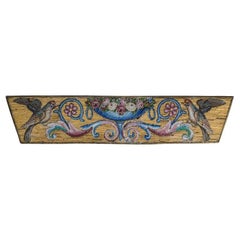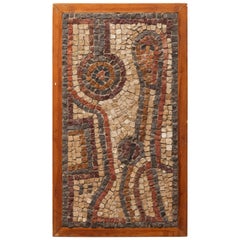Maison Nurita Decorative Art
to
1
Height
to
Width
to
1
1
1
1
1
1
1
1
Antique Gold and Multicolour Micro Mosaic Plaque with Birds and Flowers
Located in Toronto, ON
This beautiful antique multi-colored and gold leaf Micro Mosaic plaque is a rare one of a kind Maison Nurita find. The amount of detail and artistry is what makes this piece so aston...
Category
Early 20th Century Italian Wall-mounted Sculptures
Materials
Metal
Related Items
Art Deco Large And Impressive Hand Crafted 'Bathing Ladies' Wall Plaque
Located in Devon, England
This is a super rare opportunity to acquire one of these beautifully reduced versions of 'bathing ladies' the original being located in the famous Paris ''HOTEL des Collectionneur. T...
Category
21st Century and Contemporary French Art Deco Decorative Art
Materials
Plaster
$2,112 / item
H 29.14 in W 21.26 in D 2.76 in
Marble Fine Mosaic Art, Belgium, 1960s
Located in Antwerp, BE
Mid-Century Modern mosaic tableau wall piece. Abstract design of a figure in mosaic marble, shades of browns and greys.
Sturdy wooden frame.
Category
Vintage 1960s Belgian Mid-Century Modern Wall-mounted Sculptures
Materials
Marble
Raf Verjans Mosaic Aluminum Wall Sculpture
By Raf Verjans
Located in North Hollywood, CA
Brutalist mosaic aluminum and brass wall sculpture/ decor by Belgian artist Raf Verjans.
Category
Vintage 1960s Belgian Brutalist Wall-mounted Sculptures
Materials
Aluminum, Brass
Copper Rondel Plaque of Peter Paul Rubens
Located in Atlanta, GA
Molded copper rondel plaque of the great Flemish Master Peter Paul Rubens. Rubens is depicted in a high-relief bust, facing three-quarters right with a br...
Category
Early 20th Century Swedish Baroque Wall-mounted Sculptures
Materials
Copper
Italian Black and White Carrara Marble Mosaic Tiles with Florentine Monuments
Located in Firenze, IT
In the present work small handcut tiles of pure white Carrara marble are the background of this interesting contemporary mosaic which represents one of the most celebrated landmark in Florence.
The facade of the church of Santo Spirito (Holy Spirit), designed and built by Brunelleschi, is created with precious beige-colored Botticino marble tiles and surrounded by a frame of small black glass glazed paste tiles.
Carrara and Botticino are among the most famous Tuscan marbles that’s why the local mosaic artist and craftswoman- who creates this superb work of art- decided that the mosaic featuring the most important symbol of Florence should be made of these materials.
To make the composition more interesting, two different types of Carrara marble were used: the statuary white marble is matte and the white Carrara marble called "zuccherino" (sugary) is more sparkling. The random alternation of these two marbles give a pleasant vivid and three-dimensional effect to the entire mosaic tile.
Each small rectangular and squared tesserae are hand cutted and each one of these mosaic is one of a kind. The mosaic plaque has a wood panel as support and the tile is housed in hand painted giltwood frame.
The tile on sale and immediately available now is 15x15 cm and reproduces the church of Santo Spirito (Holy Spirit)- as you can see in the main image- but many other mosaic with the most important symbols and monuments of Florence are available as the Old Bridge, Santa Maria Novella, Florence's Cathedral with the Brunelleschi's dome or the Lily symbol of the city and so on, as showed in the photos.
These white and black marble mosaic tiles...
Category
2010s Italian Other Decorative Art
Materials
Marble, Carrara Marble, Statuary Marble
$535 / item
H 5.91 in W 5.91 in D 0.79 in
Glass and Stone Mosaic Abstract Wall Art Sculpture, by Han van Hattem 1964
Located in Den Haag, NL
Glass and Stone Mosaic abstract wall art sculpture, The Netherlands 1964, The Hague, By Han van Hattem
Dated and Signed 1964.
Category
Vintage 1960s Dutch Mid-Century Modern Decorative Art
Materials
Stone
$1,963
H 19.69 in W 11.82 in D 0.99 in
Metal Wall Plaques of Stylized Wine Bottles By Sexton
By Sexton
Located in Hanover, MA
1950's wall plaques made of colorfully enameled cast metal in form of stylized wine bottles. Various configurations possible as some are singles while others are doubles and triples...
Category
Vintage 1950s American Mid-Century Modern Wall-mounted Sculptures
Materials
Metal
Laverne Etched Bronze Wall Plaque "Tower of Babel"
By Philip and Kelvin LaVerne
Located in North Hollywood, CA
LaVerne etched bronze wall plaque "Tower of Babel"
There is a dent on the bottom of left side which is not very noticeable when on the wall.
Category
Vintage 1960s American Mid-Century Modern Decorative Art
Materials
Bronze, Pewter
Olympia Plaque Advertising Art Deco Chariot Gladiator
Located in Devon, England
A very attractive vintage Olympia wall plaque. There is a thin layer of copper that is embossed with the scene of a gladiator riding a chariot, very mu...
Category
Mid-20th Century European Art Deco Wall-mounted Sculptures
Materials
Copper
Art Deco 'Folies Bergeres' Large Hanging Wall Plaque, French
Located in Devon, England
This is a super rare opportunity to acquire one of these beautifully reduced versions of the facade bas-relief of the Folies-Bergeres cabaret by Maurice Picaud aka Pico (1900-1977).
...
Category
Early 2000s French Art Deco Decorative Art
Materials
Plaster
$2,112 / item
H 19.69 in W 19.69 in D 1.19 in
Heidi Melano Contemporary Sculptural Mosaic Wall Panel
By Heidi Melano 1
Located in Miami, FL
Wonderfully decorative mosaic wall art sculpture executed by Heidi Melano the world renowned artist responsible for multiple works completed for Fernand Leger, Chagall, Braque.
Hand-crafted, beautifully proportioned, this rectangle mosaic is inlaid in a slim frame. This rare work of art would make a great accent piece would enhance any wall. A true iconic piece by this artist.
Signed on the bottom right, back of panel also signed with Heidi Melano's initials.
Measures: Depth 1.25 in. x Width 28.75 in. x Height 20 in.
Would enhance any traditional, mid-century, contemporary, modern, country, beach house, ski resort setting.
About The Artist:
Heidi Melano, her maiden name Heidi Hoegger, she was born in Geneva on
April 20, 1929. Granddaughter of the great Swiss painter Ferdinand Hodler, she was passionate about art from an early age: she created, painted and lets her imagination speak by expression through different techniques. Very quickly, she wanted to become a mosaic artist. At the age of 23, she won a mosaic competition with her work "La Volière". On this occasion, she meets Lino Melano...
Category
20th Century French Mid-Century Modern Wall-mounted Sculptures
Materials
Ceramic, Glass
$6,000 Sale Price
20% Off
H 20 in W 28.75 in D 1.25 in
American Studio Ceramic Hippo Wall Plaque by Hal Fromhold
By Hal Fromhold
Located in Hamilton, Ontario
American studio whimsical ceramic hippo wall plaque by Hal Fromhold.
Category
Mid-20th Century American Mid-Century Modern Wall-mounted Sculptures
Materials
Ceramic
$1,275 Sale Price
20% Off
H 10.75 in W 15 in D 1 in


